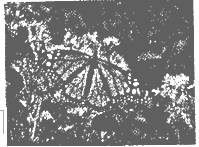题目内容
Monarch Butterfly (金斑蝶) Profile

Monarch butterflies are known for the unbelievable mass movement that brings millions of them to California and Mexico each winter. North American monarchs are the only butterflies that make such a massive journey-up to 3,000 miles (4,828 kilometers). The butterflies must begin this journey each fall ahead of cold weather, which will kill them if they delay too long.
Monarch butterflies begin life as eggs and hatch as little worms that eat their eggshells and finally, eat the milky plants on which they were placed. When fat worms become juicy, colorful and hairy, they create a hard protective case around themselves as they enter the cocoon stage. They come out as beautifully colored, black-orange-and-white adults. The colorful pattern makes monarchs easy to identify, and the unique pattern warns their enemies that the insects are terribly tasting and poisonous.
Butterflies that come out from cocoon in late summer and early fall are different from those that do so during the longer days and warmer weather of summer. These monarchs are born to fly, and know that they must prepare for their long journey because of the changing Weather. However, only monarchs born in late summer or early fall make the move, and they make only one found trip. By the time next year's winter moving begins, several summer generations wilt have stayed and died. It will be last year's settlers' great grand children that make the trip. Yet somehow these new generations know the way, and follow the same routes their ancestors took-sometimes even returning to the same tree.
Many scientists are concerned about the eastern population of monarchs, which spend the summer east of the Rocky Mountains. This group is occurring in ever smaller numbers, and its survival now is threatened by a series of natural disasters in the Mexican winter grounds and by reduced milkweed plants in their summer home.
1.What will happen to the monarch butterflies if they don't leave in fall?
A.They can't survive the very low temperature, in winter
B.They can't keep their pattern colour in changeable weather
C.They will be blown down by the strong wind in winter
D.They will be separated from each other by the cold weather
2.Form the passage we can learn that Monarchs ____________.
A.feed on their own eggs instead of milky plants
B.experience three life stages before they can fly
C.are difficult to be picked out from other insects
D.are very delicious, though they are poisonous
3.Which of the following about Monarchs is TRUE?
A.Monarchs seem to know their ancestor's hometown
B.Only last year's settlers' grandchildren make the trip
C.All the summer generations will have stayed and died
D.Only monarchs born in early autumn make the move
4.The writer seems about the present survival situation of Monarchs.
A.confident B.worried C.disappointed D.hopeful
ABAB

阅读下列短文,从每题所给的A、B、C、D四个选项中,选出最佳选项。
A
Researchers who helped discover a new species of Mexican butterfly are offering to sell the naming rights to raise money to fund more research. Co-discoverer Andrew Warren is hoping to raise at least $50,000 by auctioning(拍卖) off the rights to name the 4-inch “owl eye” butterfly, which lives in Sonora, a Mexican state bordering Arizona.
“That would support at least two years of research for our team down in Mexico,” Warren said. “Money goes a long way down here in Mexico.”
According to the scientific tradition, discoverers of a new species have the say in naming it. In recent years, some discoverers have auctioned off their naming rights to raise money.
Warren said the amount being sought for the butterfly is not out of the question, noting that naming rights for a new monkey species brought in $650,000 two years ago. A group of 10 new fish species that went on the naming auction block at the same time earlier this year brought in a total of $2 million.
The butterfly discovered by Warren and researcher George Austin ranges as far north as Mexico.
The butterfly was actually in a collection, misidentified as an example of another new species, at the McGuire Center for Lepidoptera and Biodiversity at the Florida Museum of National History in Gainesville, said Warren. They soon began the hard process of determining that it was indeed a “new” model of butterfly.
After checking photos and comparing it with other known species, they determined it was a separate species.
1.Where did the researchers discover the new species of butterflies?
|
A.In Sonora. |
B.In Mexico state. |
|
C.In a place in US. |
D.Near the US-Mexico border. |
2. Why will the researchers sell the naming rights of the butterfly?
|
A.To raise money for wildlife protection. |
|
B.To raise money for more research. |
|
C.To cause people’s attention to the new discovery. |
|
D.To cover the cost of the research. |
3.When the butterfly was first discovered, people thought ______.
|
A.it was a new species at once |
|
B.it wasn’t a species of American butterfly |
|
C.it belonged to the monarch branches |
|
D.it belonged to a new species |
4. We can infer from the passage that ______.
|
A.the new species of butterfly live both in the US and Mexico |
|
B.it took the researchers a lot of efforts to determine the new species of butterfly |
|
C.the researchers are not sure whether they can get the money they want from the auction |
|
D.it is the first time that the new species of butterfly has been found |